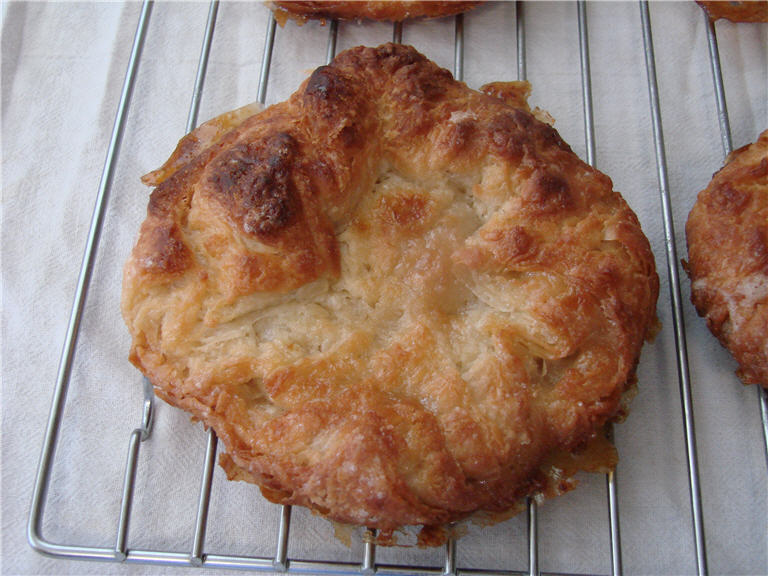About a year ago my wife, Carol, and I went to my favorite coffee store, Barefoot Coffee in Santa Clara (California). Carol doesn't like coffee so she picked out a pastry from the pastry display. It was something I'd never heard of before called a Kouign Aman. It was crispy, crunchy, sweet and buttery. It was so good that we started making trips to Barefoot just to get the pastry. We eventually found out they're made at Satura Cakes in Los Altos. Now, whenever we're in the mood for a really good pastry we go get a kouign aman.
It seemed like it was a mystery pastry because it was hard to find any information on them and what we could find often seemed contradictory. I don't know if it's true but someone told us the name means "butter cake" in the Breton language.
Today I tried making them for the first time. It is a laminated pastry, like croissants but with a couple of twists. I made a basic croissant dough and laminated it with butter as usual, except the roll-in butter was SALTED butter and weighed 50% of the detrempe weight rather than the usual 25%. The other unusual thing was that on the 2nd and 3rd turns I laminated caster sugar into it. The roll-in sugar weighed 40% of the detrempe (dough w/o roll-in butter & sugar) weight. There seem to be a lot of different, acceptable ways to shape them. I just cut the dough into 6 inch squares. For each square I folded the 4 corners to the center forming a smaller square. Then I folded the 4 corners of the smaller square to the center. After placing them on parchment I brushed them with softened butter and sprinkled them with more sugar. The kouign aman that Satura Cakes makes look like they're rolled up like sticky buns and I think they are baked in a baking dish that has butter and sugar in the bottom.
It was kind of difficult to laminate the sugar. After spreading sugar on the dough it didn't roll out as easily as croissant dough does. The dough tended to bunch up as I rolled it, maybe because sugar is rough and doesn't spread out like butter does. The other weird thing was that a lot of the roll-in sugar liquified. I think this was due to the long resting time between turns that were needed because I was rolling by hand. With a dough sheeter you could have a much shorter rest between turns and the sugar probably wouldn't have enough time to absorb so much water from the dough. I found that when laminating dough by hand I need a 2 hour rest between the 1st and 2nd turns, a 4 hour rest between the 2nd and 3rd turns, and an overnight rest between the 3rd turn and final shaping. The first hour of each rest is in the freezer, then it gets moved to the coldest part of the fridge. The final 15-30 minutes (depending on the temperature in the room) of each resting period in on the kitchen counter. I adapted the advice I got from hansjoakim and DonD on this forum and from Mark Sinclair while working as an intern at the Back Home Bakery to come up with this resting schedule. Normally for croissants I bulk ferment 1 hour at room temp. and another hour in the fridge (35-40 F). For the kouign aman I bulk fermented 1 hour in the fridge.
They're kind of rustic looking and very, very tasty. The crusty ledges around the edges are caramelized butter/sugar that leaked out, baked, and hardened.



- gcook17's Blog
- Log in or register to post comments
Croissant dough with extra butter, plus sugar--what's not to like? Unless you are a cardiologist, of course. Do these taste somewhat like Mark Sinclair's palmiers?
Paul
They're less crunchy and maybe a bit more moist, salty, and chewy (yet still sort of crunchy). They are more caramelized so the taste is different in that way.
I have been maing these for 30+ years, they area a great divergence from the normal croissant dough.
I make them slightly differently though. First off I use a European style butter (plugra is great) I do not use salted butter. It is very inconsistent in texture and flavor.
What I do use for the salt component is fleur de sel, musch smoother taste.
I also use a 4" fluted tart pan, or a silpat mat that has a tart shape. Both ways hold in the caramelazition and prevent the crispy edges.
Also when folded they are typically put in the pan upside down, so that the "X" is on the bottom.
Chef Carlton Brooks CEPC CCE ACE
Chef Carlton,
I have plenty of small tart pans so I'll do that next time...folded side down, too.
The fleur de sel I have is quite coarse. Do you grind it up or add it as is?
I assume you mean you put it in the beurrage, is that correct?
Also, how much salt do you add (as a percentage of beurrage weight)?
Thanks,
Greg